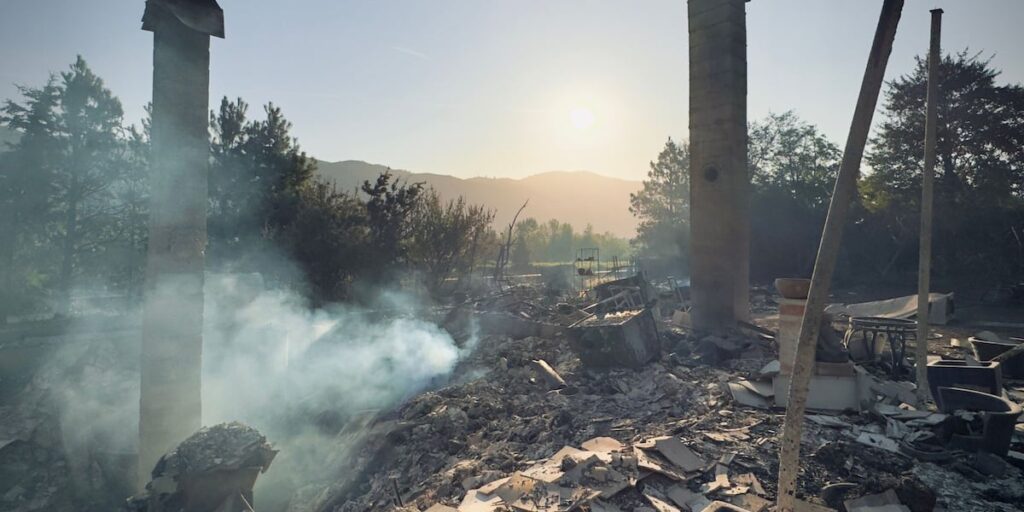WASCO COUNTY, Ore. (KPTV) – The Rowena Fire, a fast-moving wildfire, has wreaked havoc in Wasco County, leaving a trail of destruction that includes the loss of homes and extensive evacuation orders. The fire, which has burned more than 3,500 acres, prompted immediate action from local authorities and fire management agencies in response to the increasing threat it presents to communities around The Dalles and the Columbia River Gorge.
Incident Overview and Immediate Impacts
The Rowena Fire was reported around 1:30 PM on Wednesday, near the Rowena Crest viewpoint area, quickly advancing due to strong winds and dry vegetation in the Columbia River Gorge. By early evening, it had intensified to 2,500 acres and was declared a human-caused fire, although the precise cause remains under investigation by relevant authorities.
This rapid escalation triggered multiple evacuation orders across Wasco County. As of late Wednesday, over 3,300 homes were under evacuation orders, with more than 825 homes subjected to Level 3 (Go Now!) and almost 1,130 under Level 2 (Be Set) conditions. The impact was particularly visible on Interstate 84, which experienced significant closures due to thick smoke severely limiting visibility and forcing traffic to grind to a halt.
Evacuation Orders and Community Response
Evacuations began almost immediately following the fire’s discovery. The Oregon Department of Emergency Management communicated critical information as the fire spread, leading to the establishment of safe zones for displaced residents. Shelters were set up at facilities like The Dalles Middle School and the Wasco County Fairgrounds, accommodating both people and pets as they sought refuge from the escalating disaster.
Local officials, including Wasco County Sheriff’s Office and Governor Tina Kotek, emphasized the importance of heeding evacuation orders, maintaining a focused response to ensure safety during the emergency. The invocation of the Emergency Conflagration Act allowed for additional resources and support, mobilizing firefighters and incident management teams to combat the blaze.
Firefighting Efforts and Containment Challenges
As firefighters from various agencies, including the Oregon State Fire Marshal’s team, battled the stubborn wildfire, controlled burns became a crucial strategy to slow the fire’s advance. Backburns were implemented in areas west of The Dalles to clear fuel sources and contain the flames. Despite these efforts, reports indicated that as of the latest updates, the fire remained at 0% containment, frustrating firefighting teams on the ground.
“This early-season conflagration should come as a reminder to Oregonians to be ready for wildfire,” remarked State Fire Marshal Mariana Ruiz-Temple, highlighting the serious ongoing risk this season could pose for communities across Oregon. Firefighters face an uphill battle, as forecast models indicate continued dry and windy conditions that could heighten fire risks across the region.
Community and Environmental Impacts
The effects of the Rowena Fire extend beyond home loss, significantly impacting the local environment, wildlife, and air quality. Thick smoke from the blaze prompted health advisories in surrounding areas, as well as air quality warnings across several counties. Residents have been warned to stay indoors and avoid outdoor activities that could exacerbate respiratory issues linked to smoke inhalation.
Many community members have rallied together, expressing gratitude towards first responders and mobilizing local support networks to aid those displaced by the fire. Efforts by local organizations and volunteers have complemented state resources, underlining the spirit of community resilience in the face of adversity.
Looking Ahead: Preparedness and Prevention
The Rowena Fire serves as a sobering reminder of the increased wildfire risks anticipated this summer. Fire officials urge residents to prepare by creating defensible spaces around homes and developing emergency plans that include fire evacuation routes and necessary supplies.
In light of ongoing fire events, community education initiatives and fire preparedness programs are more critical than ever. As seen in the response to this fire, early preparedness and public awareness can potentially mitigate risks and save lives.
Local agencies will continue monitoring weather patterns and fuel moisture levels as they prepare for future fire seasons. The commitment to public safety remains paramount as officials coordinate resources and strategies in anticipation of ongoing challenges associated with wildfires.
Conclusions and Ongoing Developments
As the Rowena Fire continues to evolve, updates will remain fluid as officials gather data and manage firefighting efforts in real-time. The need for vigilance among residents, cooperation between community resources, and a proactive approach to fire prevention strategies will be crucial in navigating the challenges ahead.
For further information about evacuation orders and safety information, residents are encouraged to stay informed through local news channels and the Oregon Department of Emergency Management resources. Collectively, the focus remains on ensuring community safety and recovery from this devastating wildfire event.
This situation remains dynamic, and further developments regarding containment efforts, community impacts, and recovery plans will continue to unfold.

